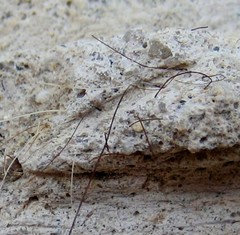

Contracts specify high quality lime and gypsum, often indicating the precise source. Thus, as lime plaster shrinks in a slow drying absorption of carbon dioxide and Plaster of Paris expands rapidly in setting, the two materials were often combined for better workability, faster set and avoidance of shrinkage. By contrast, lime’s slow carbonation allowed the plasterer up to thirty days to add ornament to the surface. An aggregate of crushed stone was used by stuccatori, in some cases of marble.
#Animal hair in plaster full
This was then mixed with water and reverted to its full form within minutes unless retarded. Gypsum plaster was made by heating gypsum, alabaster or other forms of calcium sulphate to drive off water and form the hemihydrate commonly known as ‘Plaster of Paris’.

In Italy, Spain and other Mediterranean countries gypsum was the primary material. In northern Europe lime was widely used, made from limestone that was burned and slaked and mixed with sand, water and animal hair. There are two principal types, lime and gypsum. Plaster is the most common finishing material in the early modern interior, whether plain or decorative. He points out that lime takes centuries to harden: “Lime plaster is young at 100 years.” he says.Shugborough, Aurora Ceiling, Francesco Vassalli. “Rigid gypsum plaster isn’t compatible with the softer lime,” Brennan says. Still, there are some plasterers, like Rory Brennan of Putney, Vermont, who prefer to use lime, espcially for restorations. A quarter of the century later, vitually all the lime plaster in the United States had been replaced by gypsum plasters. In 1880, a retarding agent made of ground-up horns and hooves was found to slow setting. Plaster made from calcined gypsum rock (calcium sulfate) forms a harder surface than lime without the bother of slaking and packing, but it sets almost immediately.
#Animal hair in plaster cracked
Poorly packed plaster cracked as it dried homeowners were warned to wait a year before painting. Two more layers, the brown coat and the finish coat, usually hairless, had to be “packed”-troweled again and again under pressure. The first coat, or scratch coat, oozed between the laths to form “keys” that held the plaster in place. Mixed with sand and animal hair, it was applied over lath-horizontal strips of wood or straw. The mixture reacted explosively, but when the reaction subsided, creamy white lime putty remained. The resulting calcium oxide, called quicklime or lump lime, was slaked with water (rehydrated) in sand-lined pits. Limestone was burned (calcined) to drive off water and carbon dioxide. Before then, walls were coated with lime-based plaster, which dates to the time of the pharaohs (it’s on the walls of the tombs). Most plaster used in the United States since the turn of the century is based on gypsum.
#Animal hair in plaster Patch
In 30 mintes the patch has set and the job is finished, without any need for sanding.

He then uses a sponge to touch up any surface imperfections. (5) After the first coat sets, Marshall mixes another batch of lime putty and gauging plaster (this time with less gauging so it’s easier to work) and skims a thin final coat over the entire area. (4) To reinforce the patch, he cuts a sheet of fiberglass mesh to cover the hole and presses it into the wet plaster. (3) He mixes everything with his trowel into a stiff dough, which he presses firmly onto the exposed lath and around the edges of the hole, leaving a slight depression for the final coat. (2) Marshall sifts in several handfuls of gauging plaster to give the putty more body. The putty is formed into a ring on the mixing board and the bonding agent is poured into its center. To make lime putty for the patch, Marshall mixes hydrated dolomitic lime with water until it is the consistency of whole-fat yogurt, then slakes it for at least 20 minutes, leaving a thin layer of water on the surface to ensure even rehydration. He brushes a bonding agent over the lath and all plaster being recoated, then covers all but the smallest cracks with fiberglass mesh tape. (1) The plaster around the hole is scraped smooth with an angle plane or rough drywall screen. John Marshall starts by chiseling out the old plaster from between the lath and brushing away any loose dust and plaster crumbs. Soft, crumbly plaster should be removed down to the lath and out as far as the firmly attached areas in preparation for patching.

Firm plaster that has popped off lath can be reattached with plaster washers and drywall screws. While it may be tempting to rip down an old plaster-over-lath wall and replace it with drywall, often the plaster can be saved.


 0 kommentar(er)
0 kommentar(er)
